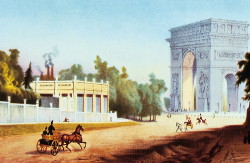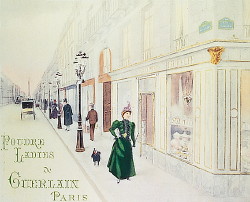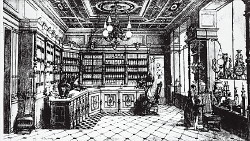 Guerlain is among the oldest perfume houses in the world. It has a large and loyal customer following, and is held in high esteem in the perfume industry. Perfumes by Guerlain are often said to be inspired by the scent of confections, as a result of a common vanilla and amber accord in many of their fragrances. This unique attribute is often referred to as the „Guerlinade”. A perfume by the same name was launched by Guerlain in 1921.
Guerlain is among the oldest perfume houses in the world. It has a large and loyal customer following, and is held in high esteem in the perfume industry. Perfumes by Guerlain are often said to be inspired by the scent of confections, as a result of a common vanilla and amber accord in many of their fragrances. This unique attribute is often referred to as the „Guerlinade”. A perfume by the same name was launched by Guerlain in 1921.
 The beginning
The beginning
The House of Guerlain was founded in 1828, when Pierre-François Pascal Guerlain opened his perfume store on 42, rue de Rivoli in Paris. As both the founder and first perfumer of the house, Pierre-François composed and manufactured custom fragrances with the help of his two sons, Aimé and Gabriel. Through continued success and the patronage of members in high society, Guerlain opened its flagship store at 15, rue de la Paix in 1840, and put its mark on the Parisian fashion scene.
The success of the house under Pierre-François peaked in 1853 with the creation of Eau de Cologne Impériale. This perfume earned Pierre-François the prestigious title of being His Majesty’s Official Perfumer (France), which lead him to create perfumes for Queen Victoria of the United Kingdom and Queen Isabella II of Spain, among other royalty.
The Second Generation
With the death of Pierre-François in 1864, the house was left to Aimé Guerlain and Gabriel Guerlain. The roles of perfumer and manager were divided between the two brothers, with Gabriel managing and further expanding the house, and Aimé becoming the master perfumer. As such, the House of Guerlain began a long tradition where the position of master perfumer was handed down through the Guerlain family.
 As Guerlain’s second generation in-house perfumer, Aimé was the creator of many classic compositions, including Fleur d’Italie (1884), Rococo (1887) and Eau de cologne du coq (1894). However, many would argue that his greatest composition was Jicky (1889).
As Guerlain’s second generation in-house perfumer, Aimé was the creator of many classic compositions, including Fleur d’Italie (1884), Rococo (1887) and Eau de cologne du coq (1894). However, many would argue that his greatest composition was Jicky (1889).
The Third Generation
The business was handed down to the sons of Gabriel Guerlain : Jacques Guerlain and Pierre Guerlain. Jacques became Guerlain’s third master perfumer in line. He was the author of many Guerlain classics, which are still held in high esteem in the modern perfume industry. Many of his perfumes are still sold and marketed today.
Among Jacques Guerlain’s most famous and popular creations are : Eau du Coq (1894), Mouchoir de Monsieur (1904), Après L’Ondée (1906), L’Heure Bleue (1912), Mitsouko (1919), and Guerlain’s flagship fragrance Shalimar (1925).
Jacques Guerlain also composed Vol de Nuit (1933) (a heavy oriental) as a tribute to Antoine de Saint-Exupéry and Air France. Ode (1955), a floral perfume similar to the likes of Joy by Jean Patou, was the last perfume composition by Jacques Guerlain. The composition of Ode was helped by his grandson, the then-18-year-old Jean-Paul Guerlain.
 The Fourth Generation
The Fourth Generation
Jean-Paul Guerlain was the last family master perfumer. He created Guerlain’s classic men’s fragrances Vétiver (1959) and Habit Rouge (1965). The latter is considered by many to be the first male oriental fragrance. He also created Nahéma (1979), Jardins de Bagatelle (1983), and Samsara (1989), as well as Héritage and Coriolan in the 1990s.
With the retirement of Jean-Paul in 2002, and no heir from inside the family to take over, the role of master perfumer is no longer tied to family succession.
Guerlain/LVMH Group
Following the acquisition of Guerlain by LVMH in 1994, perfumers outside of the family have been hired to compose perfumes for Guerlain :
• Mathilde Laurent worked as a perfumer for Guerlain. She composed Pamplelune (1999) and Shalimar Light (2003). Authorship of the latter has since been reattributed to Jean-Paul Guerlain and relaunched in 2004, after formula changes in the perfume.
• Maurice Roucel, a perfumer of Symrise, composed L’Ins tant de Guerlain (2004) and Insolence (2006).
In May 2008 Thierry Wasser was named the in-house perfumer for Guerlain and effective starting June 2008. Wasser, a Swiss perfumer who used to work for Firmenich, has created Iris Ganache and Quand Vient la Pluie for Guerlain before the appointment. Jean-Paul Guerlain is staying on in an advisory role, as a counselor to the presidency, for both fragrance design and ingredients. Wasser will work closely with Sylvaine Delacourte, Guerlain’s Artistic Director.
Famous perfumes
• Jicky (1889): Said to named after the nicknameAimé Guerlain gave to his nephew, Jacques, or after a girl who broke Aimé’s heart as a student in England; Jicky proved to be a great success in its time of creation, and remained popular ever since. Widely heralded as the first „modern” perfume, Jicky was among the first perfumes to incorporate synthetic odorants (vanillin and coumarin) in its composition, and is described by some as being the „ultimate” fougère. Although marketed by Guerlain as a women’s fragrance, it has proven popular with men.
• Après L’Ondée (1906): Meaning „After the Heavy (Summer) Shower”, Après L’Ondée is reminiscent of bitter almonds. Its composition includes violet, rose, hawthorn and hesperidic notes.
• L’Heure Bleue (1912): Meaning „The Blue Hour”, L’Heure Bleue is perfume with the dusky scent of candies and almond cake bought in an old world apothecary. Although much akin to Après L’Ondée in its pastry and almonds core, L’Heure Bleue is much less bright and more melancholic.
• Mitsouko (1919): Named after the heroine of the novel „La Bataille” by Claude Farrère, Mitsouko is said to herald the ending of World War I. Since it uses a similarly styled bottle as L’Heure Bleue, Mitsouko was likely composed as warm counterpart to the cool L’Heure Bleue. Mitsouko has the sweet smell of peach preserves and glazed danishes.
• Shalimar (1925): Named after the garden in Lahore, built by Shah Jahan in memory of his wife, Shalimar is one of the first perfumes to successfully incorporate large amounts of vanillin in its composition. The scent of Shalimar is deep and velvetly black with the scent of lemon hinted medicinal vanilla. This is the flagship perfume of the House of Guerlain.
Guerlain’s creations have long influenced the trends of perfumery with fragrances such as Jicky, Shalimar, and Vétiver. Guerlain is among the few older houses (such as Caron) that exist solely to produce and market perfumes. (Nowadays this includes a range of makeup and skincare products.) Many brands in the perfume industry, such as Chanel, Jean Patou and Gucci, are in fact divisions of fashion houses, which produce perfumes as part of a broader range of products.
Since its foundation in 1828 Guerlain has created over 300 fragrances.
Source : La Société Guerlain, Paris
